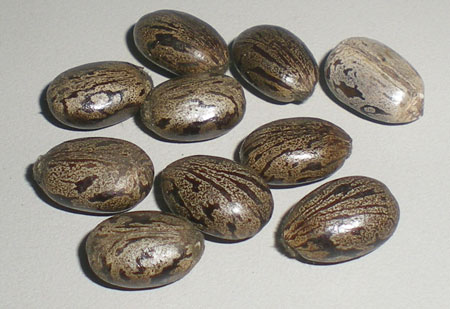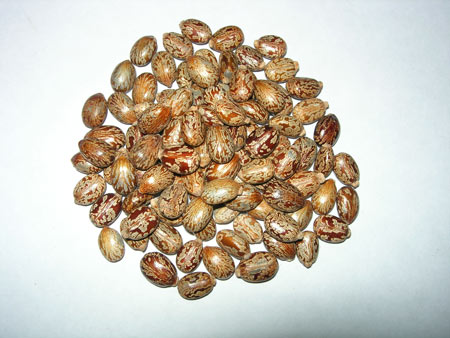
The castor plant is the source of the castor seeds. The plant is grown, mainly, for its seeds which are used to make castor oil. This oil is used in lubricants, soaps, inks, varnishes, linoleum and a host of other areas. It is a commercially important crop and is grown largely in Western India, Brazil and China. This non edible oilseed is popular as it is biodegradable and does not cause any harm to the environment. Around 50-55% oil is contained in the castor seeds.
The tiny grey seeds of the castor plant, dotted with brownish spots are contained inside the fruit. Two varieties of the castor seeds are known, one, being the red seeded and the other, white seeded. The castor oil, chiefly, consists of ricinoleate of glycerol or triricinolein along with small amounts of palmitin and stearin. Alkaloid ricinine and toxalbumine ricin are two other known components of the castor seed. Around 60% of the seeds are composed of triglycerides, largely ricinolein. The castor oil is useful for various medicinal and industrial purposes. It is used for treating various skin related disorders and can relieve swellings and pains. A lower concentration of the poison, ricin, is present in the plant. It is considered unfit for human consumption as it is highly toxic.
As early as 4000 BC, castor seeds were known to be used in Egypt. Additionally, it was used for lighting purposes and body anointments. The oil was reputed to be beneficial for improving hair growth and texture. Even queen Cleopatra was reputed to have used the plant parts as a beauty aid. Theophrastus describes the plant in his works and highlights its uses as an effective medicine. For a short period of time, it was cultivated in Europe but the yield was found to be of poor quality and the cultivation soon ceased.
Uses:
The oil from the seed has been used as lubricants in lamps and as medicines, since the ancient times. The earliest civilizations used the oil as part of rituals and sacrifices. It is useful in curing arthritis and related diseases and was credited with reducing skin irritations. Chinese medicine has been using the oil and the seeds for various purposes like medicines and dressings. These oilseeds are being used to make various types of efficient biofuels. The products of the castor seeds, including the oil are used in textiles, pharmaceuticals, plastics, paper, chemicals, greases, paints, varnishes, linoleum, soaps, cosmetics, electronics, telecommunication and other industries.









